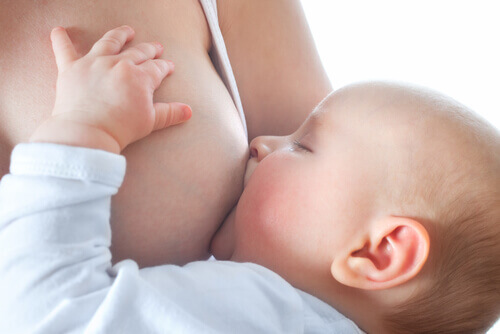The Wonder of Breastfeeding: How Breast Milk Is Produced


Written and verified by the nutritionist Saúl Sánchez Arias
Have you ever asked yourself how breast milk is produced?
The birth of a child is a wonder of human nature. Conception, gestation and childbirth are miracles in and of themselves.
But there is another miracle that occurs in a woman’s body after her child is born: She begins to produce milk.
Breasts are glands in the feminine body that are made up mainly of fatty tissue. Within this tissue, all the breast milk that a baby needs is produced.
How breast milk is produced
This source of nourishment comes from specific cells called alveoli. The milk flows through the milk ducts, called lactiferous ducts, towards the breast, where they are stored.
Specifically, the milk is stored just behind the aureola – the dark pigmented area around the nipple.
The act of breastfeeding has no relationship whatsoever with the size of a woman’s breasts or the size of her nipples.
Size normally has to do with hereditary factors that determine the number of adipose glands that a woman has.
Furthermore, women’s breasts enlarge during pregnancy, and even more so during the period of breastfeeding.

What happens within a woman’s breasts?
The important changes that occur within the interior of a woman’s breasts aren’t visible to the naked eye.
The development of the placenta sets off the release of several substances, such as progesterone and estrogen.
The purpose of these substances is to stimulate the mother’s entire biological system. This makes lactation possible.
Among the gland tissue and a good number of fatty cells in the breasts, there is a network of ducts. These mammary ducts increase both in number and in size as a result of the hormones released during pregnancy.
Within this network, the ducts can divide into smaller ducts. At the end of these smaller ducts, comparable to a bunch of grapes, are the alveoli.
These alveoli are what take all that is needed from the mother’s blood in order to produce milk. The mother’s blood provides sugars, fats and proteins.
Once the maternal milk is produced, a network of small muscles push this natural product towards the smaller ducts.
These same tiny muscles are responsible for squeezing the glands to produce the secretion of breast milk.
This complex system of ducts directs the breast milk towards a larger duct, where it is stored.
When is breast milk produced?
Experts assure us that the network of ducts described above develops during the third trimester of pregnancy. This makes it possible to nurse your baby even in the case of premature birth.
Between two and four days after giving birth, breast milk production increases considerably.
As a woman’s body prepares for lactation, a larger amount of blood is sent to the inside of the alveoli. This explains why women’s breasts become firmer and larger.
“Mothers who give birth for the second time begin to produce milk earlier than they did with their first child”
The swelling of blood vessels in the breasts, along with an abundant milk supply, cause new mothers to feel pain and pressure.
However, frequent breastfeeding during the first days of a newborn’s life will help to alleviate these symptoms.

Colostrum
During the first stage of lactation, a woman’s breasts secrete colostrum. This yellowish pasty substance has a very low fat content and is very high in protein. This is a baby’s source of nourishment during the first days after birth.
The contents of colostrum help the newborn pass his first stool and help prevent jaundice. Furthermore, colostrum is a virtual powerhouse of immune cells and antibodies that protect the baby against disease.
There are women who already experience the secretion of colostrum during the last weeks of pregnancy. In fact, some women even begin to produce colostrum as early as their second trimester.
Colostrum, also known as the “first milk,” is formed as the alveoli begin to dissolve and flow. The result is a very digestible liquid that reaches the nipples via the milk ducts.
When a baby suctions the nipple, the mother’s pituitary gland is stimulated. As a result, the gland releases oxytocin and prolactin. Oxytocin is responsible for causing the breasts to contract.
When a woman is breastfeeding, the baby’s suctioning presses down on the nipple and areola.
This compression produces an ejection reflex in the mother’s breast, and milk is released. This mechanism allows the milk to reach the baby’s mouth.
All cited sources were thoroughly reviewed by our team to ensure their quality, reliability, currency, and validity. The bibliography of this article was considered reliable and of academic or scientific accuracy.
- Uvnas-Moberg K, et al. (2020) Maternal plasma levels of oxytocin during breastfeeding—A systematic review. PLoS ONE 15(8): e0235806. https://doi.org/10.1371/
- Lawrence R, Lawrence R. Mama y fisiología de la lactancia. Capítulo 11. En Robert Resnik MD et al. Creasy & Resnik. Medicina materno-fetal. 8va Edición. 2020 Elsevier España. Año 2020.
- Hernandez Aguilar, M.T. (2019) Leche materna: ¿cómo se produce? Familia y Salud, de la Asociación Española de Pediatras de Atención Primaria. Disponible en: https://www.familiaysalud.es/vivimos-sanos/lactancia-materna/los-inicios-son-importantes/leche-materna-como-se-produce
- Eriksen KG., Christensen SH., Lind MV., Michaelsen KF. (2018) Human milk composition and infant growth. Curr Opin Clin Nutr Metab Care, 2018. 21 (3): 200-206.
- Menchetti L., Traina G., Tomasello G., Casagrande Proietti P., et al. (2016) Potential benefits of colostrum in gastrointestinal diseases. Front Biosci, 2016. 8: 331-51.
- Healthy Children. American Academy of Pediatrics. Cómo se prepara su cuerpo para la lactancia materna. Año 2015. Disponible en https://www.healthychildren.org/Spanish/ages-stages/prenatal/delivery-beyond/Paginas/How-Your-Body-Prepares-For-Breastfeeding.aspx? gclid=CjwKCAjwiLGGBhAqEiwAgq3q_vMEqTOckG5KwLHjmL0Utk7o5uS2EjnBN0r0_JlTZMpOVFCqYB08dRoCeZEQAvD_BwE
- Kent, J.C., Mitoulas, L.R., Cregan, M.D., Ramsay, D.T., Doherty, D.A., Hartmann, P.E. (2006). Cantidad y frecuencia de amamantamientos y contenido graso de la leche materna a lo largo del día Pediatrics; 117(3): e387-e395.

- Comité de Lactancia Materna de la Asociación Española de Pediatría. (2004) Lactancia Materna: Guía para profesionales. Ergón. Madrid. 2004. p 250-251. Disponible en: https://www.ascalema.es/wp-content/uploads/2014/10/Comit%C3%A9-de-Lactancia-Materna-de-la-AEP.-Lactancia-materna.-gu%C3%ADa-para-profesionales.-2004.pdf.
- Drugs. Cómo Los Senos Producen Leche. Disponible en: https://www.drugs.com/cg_esp/c%C3%B3mo-los-senos-producen-leche.html.
- KenHub. Glándula pituitaria. Disponible en: https://www.kenhub.com/es/library/anatomia-es/hipofisis-glandula-pituitaria.
- Clínica Mayo. Placenta: cómo funciona, qué es lo normal. Disponible en: https://www.mayoclinic.org/es-es/healthy-lifestyle/pregnancy-week-by-week/in-depth/placenta/art-20044425.
- Cirugías de la mama. Anatomía de la mama. Disponible en: https://www.cirugiasdelamama.com/anatomia-de-la-mama.
- Barnaclínic+. Estrógenos: ¿Qué son, cómo se producen y qué función tienen? Disponible en: https://www.barnaclinic.com/blog/womens-health/estrogenos/.
- Cigna. Leche de transición. Disponible en: https://www.cigna.com/es-us/knowledge-center/hw/leche-de-transicin-ue5267.
This text is provided for informational purposes only and does not replace consultation with a professional. If in doubt, consult your specialist.








